Online Proceedings
*Notice: PDF files are protected by password, please input "2024-20th.iPOP". Thank you.
Thursday 27, June 2024
iPOP Plenary
Thursday 27, June 2024, 10:00-12:30
Presider: Hiroaki Harai, NICT, Japan
Opening Address
Takeshi Kuwahara, General Co-Chair, NTT, Japan
Naoaki Yamanaka, General Co-Chair, Keio University, Japan
Bijan Jabbari, General Co-Chair, ISOCORE, USA
Naoaki Yamanaka, General Co-Chair, Keio University, Japan
Bijan Jabbari, General Co-Chair, ISOCORE, USA
Keynote
K-1
"Next Generation All Photonics Network in Action: Unleashing the Potential of IOWN Technologies"
Katsutoshi Itoh, Sony Corporation, Japan

Katsutoshi Itoh is a Corporate Distinguished Engineer at Sony Group Corporation and currently serves as the Senior Director and Head of Wireless Technology at Lund Research and Technology Center of Sony Corporation. His expertise lies in signal processing, protocol design, and system architecture in the field of digital communication and RF sensing. He has been actively involved in standardization communities for Cellular, WLAN, PAN, and LPWA technologies. He is the founding and current chair of the Innovative Optical and Wireless Network Global Forum (IOWN GF) Use Case Working Group, where he leads the realization and promotion of computer-integrated communication service infrastructure and platform through various photonics network technologies.
Biography:
Katsutoshi Itoh is a Corporate Distinguished Engineer at Sony Group Corporation and currently serves as the Senior Director and Head of Wireless Technology at Lund Research and Technology Center of Sony Corporation. His expertise lies in signal processing, protocol design, and system architecture in the field of digital communication and RF sensing. He has been actively involved in standardization communities for Cellular, WLAN, PAN, and LPWA technologies. He is the founding and current chair of the Innovative Optical and Wireless Network Global Forum (IOWN GF) Use Case Working Group, where he leads the realization and promotion of computer-integrated communication service infrastructure and platform through various photonics network technologies.
Yuzo Ishii, NTT Innovative Devices Corporation, Japan

In 2019 NTT launched the concept named IOWN (Innovative Optical and Wireless Network), as a next generation IT infrastructure platform with vision towards smart society, low-carbon society and well-being. Many cutting-edge technologies including Photonic disaggregated computing, All Photonics Network (APN) and Photonics-Electronics Convergence (PEC) devices are expected to accelerate IOWN.
In this session, I will share the IOWN concept/vision and technology behind, mainly focused on the PEC devices.
![]()
Biography:
Yuzo Ishii is the deputy general manager of Business Strategy Center of NTT Innovative Devices Corp. Since he joined NTT laboratories in 1997, he was mainly engaged in research and development of photonics packaging technology for next generation optical interconnections. He was also engaged in the development of wavelength-selective switches for ROADM networks. Since 2016 he was in charge of product strategy in NTT Devices Innovation Centers covering telecom/datacom, sensing and health-care devices.
At June 2022, he moved to NTT Innovative Devices Corp, which was newly founded to accelerate the Photonics-Electronics Convergence Devices for realizing IOWN.
iPOP Exhibition introduction
- iPOP Exhibition Co-Chair: Akihiro Nakamura, Spirent Communications, Japan
iPOP Showcase introduction
- iPOP Showcase Co-Chair: Shinya Nakamura, UBiqube, Japan
- iPOP Showcase Co-Chair: Yusuke Hirota, NICT, Japan
- iPOP Showcase Co-Chair: Yusuke Hirota, NICT, Japan
Local Arrangement
- iPOP Local Arrangement Chair: Akira Misawa, Chitose Institute of Science and Technology, Japan
Technical Session
Tech. Session (1):
Thursday 27, June 2024, 13:30-14:45
Chair: Naoto Yoshimoto, Chitose Institute of Science and Technology, Japan
Takahiro Ishiyama, Takashi Kurimoto, Satoru Okamoto, and Naoaki Yamanaka, Graduate School of Science and Technology, Keio University, Japan

Fiber optic access such as FTTx (Fiber To The Curb, Fiber To The Building, Fiber To The Home) is becoming more popular every year as a means of accessing the Internet. Telecommunication devices are connected to an ONU (Optical Network Unit), and the connected telecommunications devices are networked to provide various functions and services. Currently, however, this system can only be used in environments where power can be supplied to both the ONU and the telecommunications equipment. These devices require a power source, but there are places where it is difficult to secure a power source, such as in natural environments such as mountains and rivers, or outdoors in urban areas. If these devices can be driven by power via optical fiber, the application area can be expanded. Hollow Core Fiber (HCF) is an innovative optical fiber that has the potential to break through the limitations of conventional optical fibers [1].
In conventional glass core optical fibers, when the energy density becomes too high, a phenomenon called fiber fuse occurs, causing the inside of the fiber to burn. However, in HCF, light passes through air, which has nothing to burn, so no damage occurs even at energy densities 1,000 times higher than conventional fibers. This feature enables transmission of large power, which could not be achieved with conventional glass-core optical fibers. Utilizing these technologies, we are aiming to construct an IoT network driven solely by optical fiber power supply.
To realize this system, we are working on the following issues.
- High-power transmission and data communication over a single fiber by utilizing HCF.
- Implementation of a radical power-saving algorithm to enable ONUs and IoT devices to operate constantly using only optical fiber power over fiber (PWoF)[2].
- Development of a Proof of Concept (PoC) that incorporates the above two elements.
In this presentation, we will show the completion of the PoC as the first step and the results of some experiments using it.
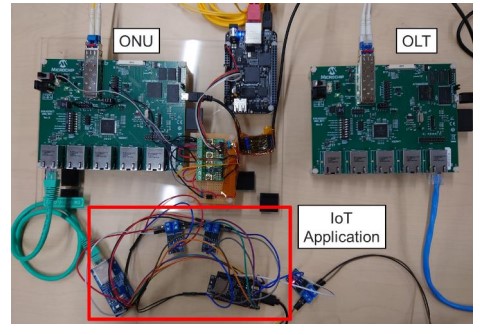
Fig.1 Constructed PoC
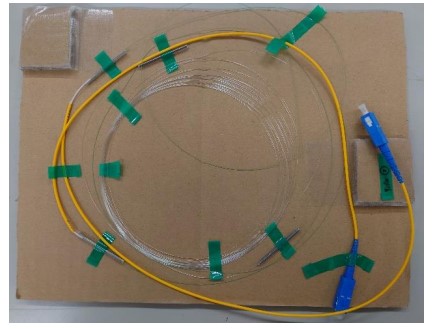
Fig.2 Hollow Core Fiber
Acknowledgments:
This research includes the results conducted under the "Research and Development of Advanced Optical Transmission Technologies for Green Society (JPMI00316)" of the Ministry of Internal Affairs and Communications (MIC) of Japan.
Reference:
- Kazunori Mukasa, "Hollow Core Fiber Cable, " Furukawa Electric Review, 2021, no. 140, p. 32-39 [Translated from Japanese.].
- Takahiro Ishiyama, Takashi Kurimoto, Satoru Okamoto, and Yamanaka Naoaki, "Power-saving performance evaluation of the adaptive deep sleep enabled PON based on applications and PON management system linkage operation, " 2023 International Conference on Emerging Technologies for Communications (ICETC 2023), Nov. 202
Biography:
Takahiro Ishiyama is a student at Keio University. He aims to construct an optical system driven solely by an optical fiber feed. On his days off, he enjoys playing volleyball with his friends.
T1-2
"Technical issues on an experiment of OpenFlow-based multi-destination VM migration across the US and Japan"
Yohei Okamoto, iD corporation, Japan, Masahiro Shibata, Kenichi Kourai, and Masato Tsuru, Kyushu Institute of Technology, Japan
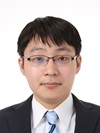
I. GLOBAL TESTBED
For experiments of globally distributed application services leveraging the edge cloud computing in an international joint research program, Japan-US Network Opportunity 2 (JUNO2), we constructed an OpenFlow-based network testbed across the US and Japan. Figure 1 illustrates the testbed consisting of several virtual machines (VMs) globally distributed at Kyushu Institute of Technology (Kyutech), The City College of The City University of New York (CCNY), StarBED as a large scale PC cluster testbed, and RISE as a wide-area OpenFlow testbed. A set of Layer2 virtual networks (VLANs) accommodates the data and control planes with a single OpenFlow controller and twelve OpenFlow switches.
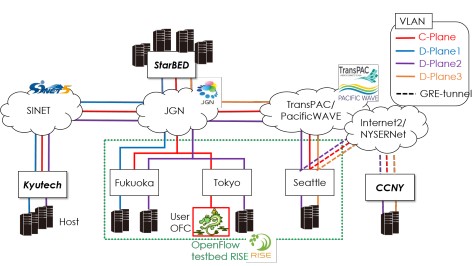
Fig.1 Globally integrated experimental testbed [1]
II. EXPERIMENT OF MULTI-DESTINATION VM MIGRATION
On the testbed, we conducted an experiment of efficiently migrating a large VM to multiple destination sites [1]. We proposed the multicast migration (Fig. 2, right) which combines two conventional methods (Fig. 2, left) to adapt to multicast settings. The full migration moves both the storage and memory contents from the old location (source) to the new location (destination). The memory migration, since the VMs in different locations can share the storage remotely, moves only the memory contents. On the other hand, the multicast migration moves (replicates) the storage contents proactively from the source to multiple destinations. Then, it performs the memory migration to one of the destinations. By replicating a large VM environment from CCNY to two sites in Japan,
we experimentally verified that the multicast migration significantly reduces the elapsed time of VM migration compared with the unicast-based full migration.
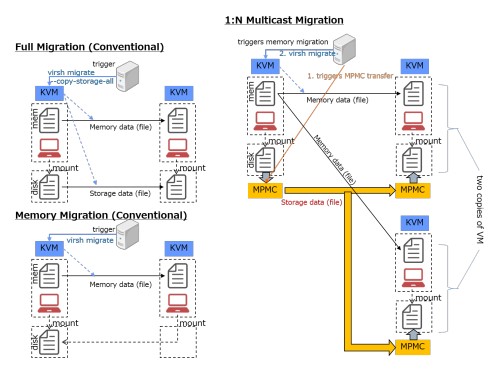
Fig.2 Full, memory and multicast migrations [1]
III. TECHNICAL ISSUES
In constructing the OpenFlow testbed network across the US and Japan and experimenting the VM migration for multiple locations, there arise various technical issues to be solved. For example, after a VM is migrated within a single IP network, accesses from users to the VM must be routed to the destination without changing the VM's IP and MAC addresses. Consequently, we developed a management system to reset the OpenFlowSwitch's MAC learning table in conjunction with the migration. We attempted to rewrite destination IP and MAC address fields in each packet by OpenFlow switch for multicasting. However, we observed a significant transmission rate reduction and decided not to use that. In Layer2 packet forwarding, the broadcast was used carefully instead of the multicast because igmpv3 was blocked in some part of the network. Since considerable packet losses were observed for large-sized packets in some network portion, we adjusted the data packet size in a trial-and-error manner.
Acknowledgments:
Supported by NICT commissioned research No.19304 and contributed by Dr. Kazumi Igarashi to the experiments.
Reference:
- K. Igarashi, A. Nagata, Y. Okamoto, M. Shibata, K. Kourai, M. Tsuru, "Efficient VM Migration for Multiple Destination Sites across a Japan-US OpenFlow Testbed" Proc. 10th International Workshop on Computer and Networking Experimental Research using Testbeds (CNERT'23), pp.1-5, May 2023
Biography:
Yohei OKAMOTO received the B.E. and M.E. degrees in computer science from the Kyushu Institute of Technology (KIT), Japan, in 2014 and 2016, respectively. He joined iD Corporation in 2016 and has been involved in research and development of SDN with OpenFlow and P4-programmable switches, and ICN/CCN-based forwarding and routing applications.
Chikara Yako, and Masahiro Hayashi, Graduate School of Integrative Science and Engineering, Tokyo City University, Japan
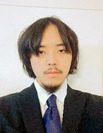
Scientists and engineers commonly outsource computations to subcontractors or external super-computers to reduce their burden. However, this causes security problems because the outsourcing side must reveal important data, such as the reliability of their equipment. Fully homomorphic encryption (FHE), illustrated in Fig. 1, solves this problem by encrypting important data using a mapping satisfying
φ(x + y) =φ(x) + φ( y), φ(x × y) = φ(x) × φ( y), and only the person who knows the secret key can decrypt the final computation result.
The IH method [1] is the only FHE that can be applied practically to cases of long digits after the decimal point, such as 0.99998 × 0.99989 (FHE over real numbers), which are especially common when computing system reliability, while almost all FHEs focus on integer or Boolean computations. However, the decrypted result by the IH method is slightly different from the one without FHE because of rounding errors.
Here, we propose a method of rounding-error-free FHE over real numbers. That is, our contribution is the improvement of FHE over real numbers to avoid the appearance of rounding erronr. Our novelity is translating the problem of the computations of long decimal numbers to integer comutation.
We explain this by using a simple example as below.
We find that 0.99998 × 0.99989 is translated to (1 – 2T) × (1 – 11T) = 1 – 13T + 22T2, where this translated problem is solved by only integer computation as for coefficients of polynomials. We use FHE to outsouce this coefficient computation. Now, we obtain 0.99998 × 0.99989 = 0.99987002 by inputing 0.00001 to 1 – 13T + 22T2 = (1 × T–2 – 13T × T–1 + 22) × T2 = (1 × 10000000000 – 13 × 100000 + 22) × 0.0000000001. The last part of these equations is excecuted by integer computation and change of decimal point. That's why, rounding error never appears in our proposal.

Fig. 1 Fully homomorphic encryption.
Reference:
- N. Nakadai et al., "Improving the security strength of Iseki's fully homomorphic encryption", ITC-CSCC, pp. 299-304, 2020.
Biography:
Chikara Yako was born in Aichi, Japan in 2001. He received the bachelor's degree from Tokyo City University in 2023. He is currently a master's degree student in Major of Information Engineering, Tokyo City University. His research focuses on include rounding error reduction of secret calculations in the field of reliability.
Showcase Presentation
Showcase Presentation
Thursday 27, June 2024, 14:45-15:15
Technical Session
Tech. Session (2):
Thursday 27, June 2024, 15:45-17:00
Chair: Yoichi Sato, Open Systems Laboratory, Japan
Ryuta Murakami, Kojiro Nishimura, Satoru Okamoto, Takashi Kurimoto, Yoshihiko Uematsu, and Naoaki Yamanaka, Graduate School of Science and Technology, Keio University, Japan

In beyond 5G era, it is expected to faster, higher capacity, lower delay, and more secure communication. In order to achieve these targets, it is necessary to use high frequencies such as millimeter waves and tera-hertz waves. However, high frequencies have issues with straightness and attenuation of radio waves, thus microcells (i.e., cell radius is about 10 m) must be created by deploying a large number of antennas for ensuring coverage area. Toward the realization of microcells, we address some issues: deploying new optical fibers, the way of power supply to many radio units (RUs), and further high-speed signal processing in RUs. Therefore, we have proposed the switched radio over fiber (Switched RoF) with an optical switch between the small optical power feed antennas and the signal processing units in central units (CUs) or distributed units (DUs), aiming for a new mobile front haul (MFH) with analog radio over fiber (A-RoF) and power over fiber (PWoF) using hollow core fibers (HCFs) [1]. Since the cell radius is extremely small in the proposed architecture, the number of users in a microcell is expected to be zero or one. In addition, it leads to personalization of cells, thus Switched RoF using optical switch can achieve higher functionality as shown below.
- Power saving by (1) turning off the signal processing units in CUs/DUs connected to no users cells and (2) aggregating them into the same nodes as much as possible for turning off other nodes [2].
- High reliability by using N + 1 redundant signal processing units.
- Low-cost construction with N < M (the number of signal processing units is N and the number of antennas is M).
- Cell tracking in response to user movement for handover acceleration, etc.
Because of providing the power saving function and cell tracking function, it is necessary to identify user's location. Hence, we utilize macro cells as a C-plane by means of a hierarchical cell structure and microcells are used as a U-Plane [3].
In this study, we used a Linux PC based Wi-Fi access point (Wi-Fi AP) as a base station (i.e., CU/DU), commercially available A-RoF modules, a micro electro mechanical system (MEMS) optical switch, and installed HCF cables in the experiment. We confirmed that the concept and effectiveness of the cell tracking function using optical switch in the Switched RoF.
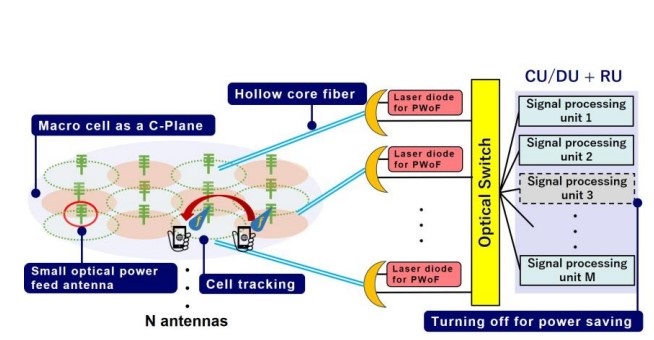
Fig. 1 The overview of switched RoF architecture.
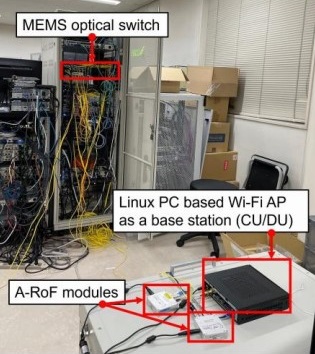
Fig. 2 The devices used in the experiment.
Acknowledgments:
This work was supported in part by the National Institute of Information and Communications Technology (NICT) (JPJ012368C07101). This research was conducted at the Keio Future Optical Network Open Lab.
References:
- S. Okamoto et al., "Beyond 5G Mobile Front Haul Networks using High Power Transmission Radio over Fiber Technologies," IEICE Tech. Rep., vol. 122, no. 398, PN2022-56, pp. 70-76, Mar. 2023 (written in Japanese).
- R. Murakami et al., "Power Saving Effects in Switched RoF," IEICE Tech. Rep., vol. 123, no. 442, PN2023-80, pp. 58- 63, Mar. 2024 (written in Japanese).
- H. Ishii, et al., "A novel architecture for LTE-B:C-plane/U-plane split and Phantom Cell concept," Proc. in 2012 IEEE Globecom Workshops, pp.624-630, Dec. 2012.
Biography:
Ryuta Murakami received his B.E. degree from Keio University in 2023. He is currently a master course student in Graduate School of Science and Technology, Keio University.
Kojiro Nishimura, Ryuta Murakami, Yoshihiko Uematsu, Satoru Okamoto, and Naoaki Yamanaka, Graduate School of Science and Technology, Keio University, Japan
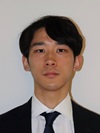
We are attempting to further improve high-speed and large-capacity communication services for Beyond 5G. For this purpose, it is necessary to increase the bandwidth by utilizing millimeter waves and terahertz waves, which have problems of high straight-line propagation and large attenuation. To overcome these problems, we have proposed multi-spot Radio over Fiber (RoF) concept, which is a mobile fronthaul network (MFH) using optical couplers (splitters) and combining Analog-RoF (A-RoF) transmission technology for covering many small cells by single frequency from one base-station as shown in Fig. 1 [1].
In conventional macro cells, a single low frequency (e.g. 800 MHz) is used to cover a wide area, so the communication capacity, which is “not large”, is divided and used by many people. In the multi-spot RoF, a single high frequency (over 28 GHz) is used in many small areas, so “large” communication capacity is divided and used by many people. Therefore, the multi-spot RoF will providea significant increase in the communication capacity allocated to a single user. In addition, the coupler enables the same high-frequency radio signals to be transmitted and received via multiple antennas for both uplink and downlink, thereby extending the reach of high-frequency radio signals. Thus, radio frequency resources can be flexibly shared among antennas, leading to a reduction in the amount of equipment at the base station. A simple emulation of multi-spot RoF was performed using an AP module (Jetson TX2) that transmits Wi-Fi and commercial A-RoF transmission modules, as shown in Fig. 2.
In this experiment, we inserted optical couplers in the down and up directions to verify the influences of splitting and combining optical signals, as well as the influences of different optical fiber paths assuming a cell boundary. Specifically, the optical fiber sections were given various distance differences of 10 m, 20 m, and 10 km. The results showed that when the optical fiber length difference of two paths is sufficiently small compared to the one symbol length of 802.11n, there is little interference between two optical signals and the communication quality is good.
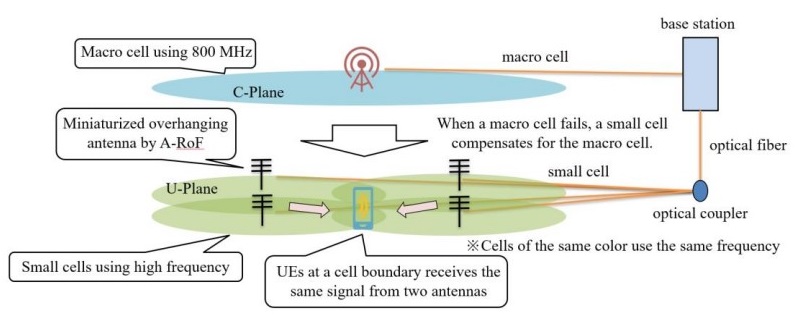
Fig. 1 Overview of the multi-spot RoF
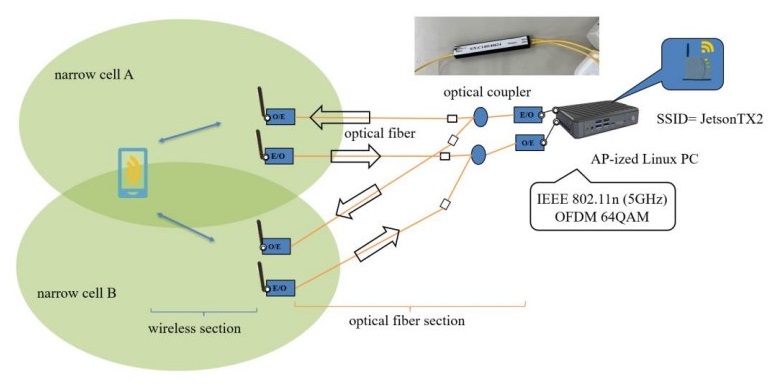
Fig. 2 Experimental system overview using Wi-Fi AP.
Acknowledgments:
This work was supported in part by the National Institute of Information and Communications Technology (NICT) (JPJ012368C07101). This research was conducted at the Keio Future Optical Network Open Lab.
References:
- S. Okamoto et al., "Beyond 5G Mobile Front Haul Networks using High Power Transmission Radio over Fiber Technologies," IEICE Tech. Rep., vol. 122, no. 398, PN2022-56, pp. 70-76, Mar. 2023 (written in Japanese).
Biography:
Kojiro Nishimura received his B.E. degree from Keio University in 2024. He is currently a master course student in Graduate School of Science and Technology, Keio University.
T2-3
"Virtual optical network embedding in spectrally-spatially elastic optical networks considering dynamic scenarios"
Vinay Kumar, South Asian University, India, Eiji Oki, Kyoto University, Japan, and Bijoy Chand Chatterjee, South Asian University, India

Infrastructure as a service (IaaS) allows the different parties to share the physical infrastructure of the optical network resources using network virtualization to accommodate the exponential growth of inter-network services. The virtual optical network embedding (VONE) enables efficient resource virtualization to map several VON requests over a substrate optical network. On the other hand, the spectrally-spatially elastic optical network (SS-EONs) is becoming a promising solution for the increasing volume of the demanded traffic due to its higher fiber capacity [1,2]. Taking this direction, the work in [3] presented a routing, spectrum, core, and mode allocation (RSCMA) model for VONE over SS-EONs while avoiding inter-core and inter-mode crosstalks (XTs), and the work in [4] considered an XT-aware approach for RSCMA model for VONE over SS-EONs. The model in [3,4] allocates spectrums to virtual optical network (VON) requests over the substrate SS-EONs while maintaining the spectrum continuity, spectrum contiguity, core continuity, and mode continuity constraints [5]. The work in [3,4] modeled RSCMA for the VONE problem over SS-EONs as an integer linear programming (ILP) to maximize the number of VON requests placed in the substrate network. They introduced a heuristic when the optimization problem is not tractable for large networks. This motivates us to use these ILP-based heuristics and evaluate them in dynamic traffic.
We consider XT-avoided and XT-aware approaches for VONE over SS-EONs for performance evaluation. To illustrate the two approaches, we consider a two-core fiber; each core has two modes in Fig. 1(a). The adjacency of the core-mode structure is shown in Fig. 1(b). Four sample VON requests are considered for demonstration purposes. We focus on a single link, A-B, to showcase resource allocation. To mitigate XT, the XT-avoided approach restricts allocating the same spectrum slots in adjacent modes of the same core and adjacent cores of the same mode, as illustrated in Fig. 1(c). Consequently, the allocation of c1m2 and c2m1 is restricted due to the usage of c2m2 and c1m1. While this approach offers computational simplicity, it often results in suboptimal resource utilization due to XT-avoided unutilized slots [2]. Conversely, the XT-aware approach allocates spectrum resources while adhering to inter-core and inter-mode XT-aware constraints, permitting the use of the same spectrum slot in adjacent modes of the same core and adjacent cores of the same mode if XT remains below a predefined XT threshold, as shown in Fig. 1(d), and hence allowing usage of c2m1 to serve r4 despite having induced XT from the adjacent core. Despite their higher computational complexity, the XT-aware approach is favored by network operators for their superior resource utilization. Based on the two approaches, the work in [3,4] presented ILP-based heuristics. We employed these heuristics to serve the dynamic traffic and evaluated their performances.
We consider parameters and settings for the evaluation according to [3]. We employed an Erlang-based traffic model to generate the traffic where the inter-arrival and holding times are generated using an exponential distribution. We considered the XT threshold to be - 27dB. The reported results have a confidence interval of 95% with an error margin of less than 5%. The results (as shown in Fig. 2) show that the traffic admissibility is increased by 29% and 26% for the XT-aware approach compared to the XT-avoided approach under 1% blocking probability for both the National Science Foundation network and the US network, respectively.
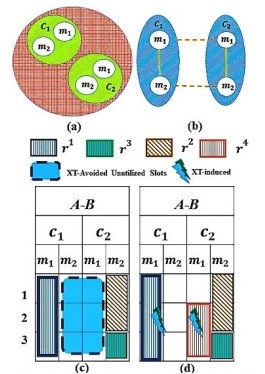
Fig. 1 (a)core-mode structure, (b)reduced core-mode adjacency, (c)XT-avoided approach, (d)XT-aware approach.
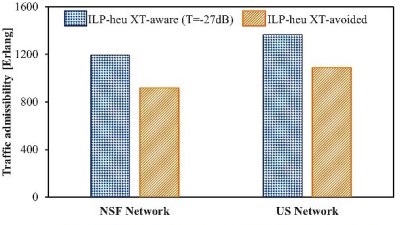
Fig. 2 Traffic admissibility using XT-aware and XT-avoided approach under 1% blocking of requests.
References:
- B. C. Chatterjee, A. Wadud, I. Ahmed, and E. Oki, "Priority-based inter-core and inter-mode crosstalk-avoided resource allocation for spectrally-spatially elastic optical networks," IEEE/ACM Trans. Netw., vol. 29, no. 4, pp. 1634–1647, 2021.
- I. Ahmed., E. Oki, and B. C. Chatterjee, "Modelling and analysis of crosstalk-avoided and crosstalk-aware approaches in spectrally-spatially elastic optical networks." Comp. Netw., 2024.
- V. Kumar, J. Halder, A. Mitra, E. Oki, and B. C. Chatterjee, "Inter-core and inter-mode crosstalk-avoided virtual network embedding in spectrally-spatially elastic optical networks," in Proc. IEEE 23rd Int. Conf. High Perf. Switch. Rout. (HPSR). IEEE, 2022, pp. 125-130.
- V. Kumar, J. Halder, E. Oki, and B. C. Chatterjee, "XTawVNE: Inter-core and inter-mode crosstalk-aware virtual network embedding in spectrally-spatially elastic optical networks," in Proc. IEEE Int. Conf. Adv. Netw. and Telecom. Sys. (ANTS). IEEE, 2022, pp. 225-230.
- L. Gong and Z. Zhu, "Virtual optical network embedding (VONE) over elastic optical networks," J. Lightw. Technol., vol. 32, no. 3, pp. 450-460, 2014.
Biography:
Vinay Kumar is currently pursuing his PhD at South Asian University, New Delhi, specializing in Optical Networks. He earned his bachelor's and master's degrees in Informatics and Communication from the University of Delhi, India, in 2017 and 2019, respectively.
Friday 28, June 2024
Technical Session
Tech. Session (3):
Friday 28, June 2024, 10:00-11:15
Chair: Rie Hayashi, NTT, Japan
T3-1
"A Novel Crossed Dipole Loop Rectenna Array for Simultaneous LEDs Lighting using Wi-Fi Radio Waves"
Tamami Maruyama, Heinen Olan, Noa Ebita, Masashi Nakatsugawa, National Institute of Technology, Hakodate College, Japan, Masay Tamura, Toyohashi University of Technology, Japan, and Noriharu Suematsu, Tohoku University, Japan

In the energy harvesting technology utilizing Wi-Fi radio waves to power LEDs and sensors, the authors have previously reported an intriguing phenomenon whereby the farther the receiving elements are increased by applying the principles of Yagi-Uda antenna's director, the farther the power can be wirelessly transmitted [1]. In contrast, in this study, a crossed dipole loop rectenna is constructed with two LEDs and one rectifying diode illuminated by wireless power transmission, and by arraying them, it is demonstrated that multiple LEDs located more than 150mm away from the wave source can be illuminated using the Wi-Fi tethering mode of a smartphone. The structure of this antenna is shown in Figure 1, where the elements in the horizontal direction form a loop shape, differing in shape and characteristics from a conventional crossed dipole antenna. The rectenna was arrayed, and experiments to illuminate LEDs using the Wi-Fi tethering mode were conducted. The results are shown in Figure 1, where six LEDs equivalent to two elements are illuminated near the wave source, and two LEDs of the elements located 150mm away from the wave source are also illuminated simultaneously. The analysis results of wireless power transmission efficiency are presented in Figure 2. It is confirmed that the wireless power transmission efficiency is again high not only near the wave source but also 150mm away from it, demonstrating the effectiveness of this method.

Fig.1 Analysis model of Crossed Dipole Loop Rectenna Array and Experiment of LED's Illumination using the prototype of Crossed Dipole Loop Rectenna Array
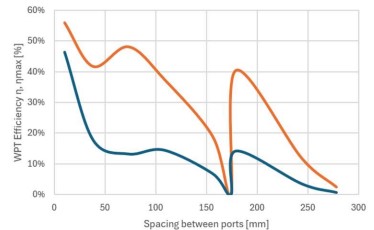
Fig.2 Simulation results
Acknowledgments:
This work was supported by Collaborative Research Program 2023 Information Initiative Center, Hokkaido University, Japan. This work was partially supported by JSPS KAKENHI Grant Number C21K04050, 24K07497 and the Research Institute of Electrical Communication, Tohoku University.
References:
- T. Maruyama, "Energy harvesting rectenna applying the theory of Yagi Uda antenna," in Proc. ISAP 2019, vol.1, no. 607, pp. 14.
Biography:
Tamami Maruyama received her B.S. and M.S. degrees in 1985 and 1988, respectively, from the department of mathematics, Tsuda University, Tokyo, Japan. In 2001, she received her Ph.D. degree from Tohoku University, Sendai, Japan. In 1988, she joined the Nippon Telegraph and Telephone Corporation (NTT). In 2003, she joined NTT DOCOMO INC. In 2014, she joined National Institute of Technology, Hakodate College as professor. In 1995, she received the Young Engineer Award from IEEE AP-S Tokyo Chapter. In 1998, she received the Excellent Paper Award from the IEICE. In 2008, she received the Best Paper Award from ISAP 2008. Prof. Maruyama is a member of the IEEE and IEICE. Her main research interests include the application of the meta-surface, metamaterials and reflectarray to wireless communications, wireless power transmission.
T3-2
"Concealing Formulas in Fully Homomorphic Encryption Used in Computations of Network Reliability"
Eishun Yokozeki, and Masahiro Hayashi, Graduate School of Integrative Science and Engineering, Tokyo City University, Japan
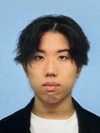
Fully homomorphic encryption (FHE) is used by scientists and engineers to outsource the work of computations to subcontractors. It uses a mapping Φ satisfying Φ(x + y) = Φ (x) + Φ(y), Φ(x × y) = Φ (x) × Φ(y) for numbers x and y, and only the outsourcing side can make Φ−1 . For example, if 3 + 2 × 5 is outsourced, then the subcontractor computes Φ(3) + Φ(2) × Φ(5) = Φ(3 + 2 × 5) = Φ(13). In this case, the outsourcing side gets 13 from Φ−1(Φ(13))
The IH method [1] is the only practically applicable FHE to numbers having many digits after the decimal point, such as 0.99987+0.99967×0.00045, and it is especially useful for computing the network reliability (probability of network being in the working state) from the link reliabilities (probabilities of the links working, denoted by Ri, with i being natural number), as is commonly done in network design.
On this topic, we recently developed a new extension to conceal not only Ri but also the topology of the network by adding dummy links to the original topology [2]. However, we make a further claim here that it is not easy to determine the places at which we should add dummy links. For example, readers may feel that the original topology can be roughly estimated from r. h. s. in Fig. 1 (this example is in ref. [2]), while the bold lines are dummy links.

Fig.1 The conceal of topology.
We propose a new approach to solve this problem. The key idea is that the outsourcing side never reveals the topology, but reveals a formula for network reliability with added dummy parameters. For example, the outsourcing side could reveal R1 × R2 + R3 - R4× R5 × R6 with R1 and R2 being link reliabilities while the other parameters each take the value 1. Compared with the method in ref. [2], this method makes it more difficult for the subcontractor to derive the original formula R1 × R2 from Φ(R1) × Φ(R2) + Φ(R3) - Φ(R4) × Φ(R5) × Φ(R6) because the human eye is less able to see an embedded original formula than a diagram.
References:
- N. Nakadai et al. "Improving the security strength of Iseki's fully homomorphic encryption", ITC-CSCC, pp. 299-304, 2020.
- DOI: 10.1109/apcc55198.2022.9
Biography:
Eishun Yokozeki was born in Kanagawa, Japan in 2001. He received the bachelor's degree from Tokyo City University in 2024. He is currently a master's degree student in Major of Information Engineering, Tokyo City University. His research focuses on secure computation for safe outsourcing.
T3-3
" Improvement of Method to Compute Security Strength for (k, n)-Threshold Secret Sharing Scheme"
Souta Sugiyama, and Masahiro Hayashi, Graduate School of Integrative Science and Engineering, Tokyo City University, Japan

(k, n)-threshold SSS is a common type of secret sharing scheme (SSS), where information (called a 'secret') is split into multiple pieces (called 'shares') and a hacker can decipher it if and only if he can collect k or more shares.
While many papers have reported methods to execute SSS, ref. [1] was the first to point out the significance of the problem of allocating shares on a network and made a model using a graph with domains, where nodes are categorized into 'shareholders', 'intrusion gates', and 'transition nodes'. Domains D1, D2, … , Dm are sets of nodes with the following properties:
- Each domain is either 'open' or 'closed'.
- The probability of domain Di being open, denoted by pi, is known.
- Each shareholder has a share, and a hacker can collect this share if and only if
4-1 There is a path between this shareholder and one of the intrusion gates
4-2 Any domain through which this path goes is open.
In Fig. 1, the nodes in each dotted closed curve comprise a domain, filled circles and double circles show intrusion gates and shareholders, respectively, while the other nodes are transition nodes.
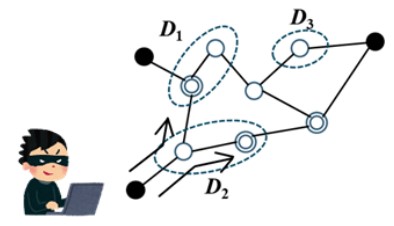
Fig.1 Conceptual figure of model.
Ref. [1] proposed to use PL, defined as the probability of a hacker succeeding in deciphering the secret, as the security strength for (n, n)-threshold SSS. Ref. [2] extended the algorithm so that it could compute PL for (k, n)-threshold SSS as follows.
Input: model Output: PL
- If pi of every domain is 0 or 1, then compute PL and end after outputting PL.
- If a hacker cannot collect k or more shares even if any domain with pi ≠0 are assumed to be open, then output 0 and end.
- Select a domain Di to create two models M1, by setting pi = 1, and M2, by setting pi = 0.
- Output pi×Fact(M1)+(1-pi)×Fact(M2)
- https://ieeexplore.ieee.org/stamp/stamp.jsp?tp=&arnumber=9182786
- 10.1109/APCC55198.2022.9943643
In this study, we propose a further improvement that modifies step 2 by changing 0 to 1 and 'open' to 'closed'. Numerical examples demonstrate the effectiveness of this proposal.
References:
Biography:
Souta Sugiyama was born in Kanagawa, Japan in 2001. He received the bachelor's degree from Tokyo City University in 2023. He is currently a master's degree student in Major of Information Engineering, Tokyo City University. His research focuses on security strength evaluation and methods for telecommunications networks.
Keynote
Friday 28, June 2024, 11:25-12:15
Chair: Eiji Oki, Kyoto University, Japan
Kenichi Tayama, NTT Access Network Service Systems Laboratories, Japan

NTT Group is working towards the realization of the IOWN concept and the Cognitive Foundation CF concept that supports its infrastructure and services. The NTT Group is also working to make networks more robust in the event of large-scale disasters or failures. Furthermore, the recent development of AI-related technologies, including generative AI, is remarkable. In light of these circumstances, I would like to introduce NTT Laboratories' efforts to realize the CF concept and autonomous network, along with the possibilities of utilizing generative AI. In addition, I will introduce specific initiatives, such as fundamental technologies that support initial response in the event of large-scale failures or disasters.
![]()
Biography:
Kenichi Tayama joined NTT Optical Network Systems Laboratories in 1995. Since he joined NTT, he was engaged in the research and development of network operations. Then he also worked at NTT EAST's IT Innovation Department for five years from 2009 and was engaged in planning and development of internal IT systems. After that, he was worked at NTT-ME's Network Operation Center for three years from 2014 and was engaged in network operations and maintenance. He is now a group leader, senior research engineer, supervisor, Operation Information Management Technology Group in NTT Access Network Service Systems Laboratories, where he researches and develops network operations support systems.
Sponsor Session
Friday 28, June 2024, 13:30-14:10
Chair: Hirofumi Yamaji, TOYO Corporation, Japan
Ryuta Murakami, Keio University, Japan
Biography:
Ryuta Murakami received his B.E. degree from Keio University in 2023. He is currently a master course student in Graduate School of Science and Technology, Keio University.
Takafumi Fukatani, NTT, Japan
Biography:
Takafumi Fukatani received the B.E. and M.E. degrees in electronic engineering from University of Electro Communications in 2010 and 2012, respectively. In 2012, he joined the NTT Network Service Systems Laboratories, where he was engaged in research on optical cross-connect systems. He is currently researching architecture of optical transmission node for All-Photonics Network.
Special Panel Session
Friday 28, June 2024, 15:00-16:30
Special Panel Session
Theme of Special Panel Session: Innovation in Optical Technology
Moderator:
Ved P. Kafle, NICT, Japan
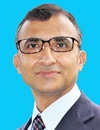
Panelists:
- Kazunori Mukasa, Furukawa Electric Co., Ltd., Japan
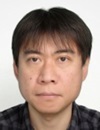
- Morio Takahashi, NEC Corporation, Japan

- Ben Puttnam, NICT, Japan
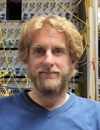
Theme of Special Panel Session: Innovation in Optical Technology
Moderator:
Ved P. Kafle, NICT, Japan

Biography:
Ved P. Kafle received a B.E. degree in electronics and communications engineering from Punjab Engineering College, Chandigarh, India, an M.S. degree in computer science and engineering from Seoul National University, South Korea, and a Ph.D. degree in informatics from the Graduate University for Advanced Studies, Japan. He joined the National Institute of Information and Communications Technology (NICT), Tokyo, Japan, as a researcher in 2006. He is currently working as a research manager at NICT and concurrently holding a visiting associate professor’s position at the University of Electro-Communications, Tokyo, Japan. His recent research interests include 5G and beyond network architectures, Internet of things (IoT), network resource management, network operation automation by AI/machine learning, and standardization. He has been serving as a co-rapporteur of ITU-T Study Group 13 since 2014. He received the ITU Association of Japan’s Encouragement Award and Accomplishment Award in 2009 and 2017, respectively. He has also received four Best Paper Awards from the ITU Kaleidoscope Academic Conferences in 2009, 2014, 2018, and 2020. He is a Fellow of ITU-T Study Group 13 and a member of the IEEE and the IEICE.
Panelists:
- Kazunori Mukasa, Furukawa Electric Co., Ltd., Japan

Theme:"Next-generation transmission fiber technologies"
Biography:
Kazunori Mukasa received B.E. and M.E. degree in Electrical Engineering from Waseda University, Tokyo, Japan in 1994 and 1996. He joined Furukawa Electric, Chiba, Japan in 1996 and has been mainly investigated new types of transmission fibers. From 2004 to 2006, he worked as a visiting researcher in ORC, University of Southampton, the U.K. From 2012 to 2015, he belonged to OFS Laboratories, the USA as a visiting researcher. Now, he is a manager and senior researcher of Photonics laboratories of Furukawa Electric, Mie, Japan, and mainly investigating the next-generation transmission fibers, including innovative silica fibers and hollow-core fibers.
- Morio Takahashi, NEC Corporation, Japan

Theme:"Silicon photonics technology for compact and low-power optical transceivers"
Biography:
Morio Takahashi is a Senior Research Engineer in the NEC Fiber Optic Devices Department. He received his Ph.D. from Tokyo University of Agriculture and Technology in 2001. Since joining NEC Corporation in the same year, he has been involved in the research and development of optical waveguide devices and transceivers for optical communication networks. In recent years, he has focused on developing silicon photonics devices, particularly hybrid integrated wavelength-tunable lasers.
- Ben Puttnam, NICT, Japan

Theme:"Transmission technologies using large scale multiplexing in wavelength and space"
Biography:
Ben Puttnam is Chief Senior Researcher with the Photonic Network Laboratory at the National Institute of Information and Communications Technology (NICT), Tokyo, Japan. He received the M.Phys. degree in physics from the University of Manchester, U.K, and the Ph.D. degree from University College London, U.K in 2008. In between, he was a switch design engineer at T-Mobile, U.K. After research visits to NICT, supported by JSPS and the Photonics group at Chalmers University, Sweden, supported by the Ericsson research foundation, he re-joined NICT, with current research interests focusing on space-division multiplexing and multi-band WDM technologies including devices, systems, and networking.
Closing Session
Friday 28, June 2024, 16:30-16:50
Closing by iPOP Organization Committee Co-Chair
Satoru Okamoto,Keio University, Japan
Closing by iPOP Organization Committee Co-Chair
Satoru Okamoto,Keio University, Japan